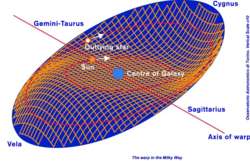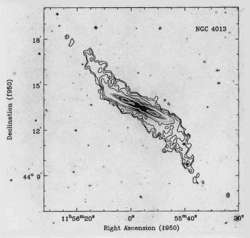Galactic warps
James Binney, Andrew EyreThe warp of the Milky Way
In many galaxies interstellar gas and dust are concentrated into a thin
layer. In the Milky Way galaxy the Sun is located within this layer, so
we can study it in great detail. It has three main components of
different thicknesses. The thinnest layer is about 80 pc (240 light
years) thick and is made up of cold (T~30 K) dense clouds of molecular
hydrogen and atomic helium. This layer is embedded in a layer ~200 pc
thick of atomic hydrogen and helium at temperatures up to 1000 K. This
layer is itself embedded in a thicker layer still of very much hotter,
partially ionized gas. 
This layered structure extends (with variations in surface density) from the centre of the Galaxy out to 20 kpc or more, although each component gets thicker as one goes outwards, and becomes significantly thicker than the numbers just quoted at radii R > 12 kpc. So as a first approximation we may think of the atomic layer as a disk 20 kpc in radius and 200 pc thick; that is a disk whose thickness is of order 1% of its radius. It's a very thin disk indeed!
Interior to the Sun, this layer is pretty flat, so it defines a plane. Beyond about 12 kpc the mid-points of the layer deviate significantly from this plane: in the general direction of the Magellanic clouds, the layer lies below the plane defined by the inner Galaxy, while at diametrically opposed points it rises above the plane. It seems that the outer hydrogen disk of the Galaxy is warped. The warp was discovered when the first surveys of the Galaxy in the 21 cm line of hydrogen were completed in 1957. In the 1970s similar surveys of hydrogen in external galaxies revealed that of order 50% of disk galaxies have warped hydrogen disks. Detecting warps in stellar disks is hard, but both infrared observations of integrated starlight and studies of the distribution of stellar velocities near the Sun suggest that the Galaxy's stellar disk is warped too.
The physics of galactic warps
The physics of warps is hard to understand. If the Galaxy were an isolated body, Hunter & Toomre showed in 1969 that if the disk were initially set up warped, the energy associated with the warp would soon reorganize the disk into a spiral corrugation wave, which would then propagate through the disk to large radii, where the energy of the wave would be converted into random vertical motions of stars. In short, in an isolated galaxy an initial warp would soon disappear, and leave as its only trace a thickening of the edge of the disk.
When at the end of the 1970s astronomers became convinced that galaxies were embedded in massive dark halos, it was natural to ask whether warps arose through some interaction between the disk and the dark halo through which it moved. At one time it seemed possible that the halo could actually excite a warp: perhaps `dynamical friction' between the disk and a spherical halo (Bertin & Mark 1980) or resonant interactions with a triaxial halo (Binney 1978) could continually replenish the energy carried off by corrugation waves. A possibility that attracted a lot of attention was that the dark halo was axisymmetric but flattened in just such a way that the warp did not wind up into corrugation waves, but continued indefinitely as a standing wave in the disk (Spark & Casertano 1988).
It now seems that none of these mechanisms is viable (Binney Jiang & Dutta 1998). The more plausible of them fail when the dark halo is modelled correctly as a deformable mass of collisionless particles, rather than as a rigid body, as was commonly done in early work.
 |
| Fig. 1: Total HI superimposed onto an
optical map of NGC 4013 Credit: R. Bottema, WSRT |
Observational evidence
Observations confirm that the Galaxy is accreting a great deal of angular momentum about axes that are far from parallel to the symmetry axis of the inner galaxy. Specifically, in 1995 astronomers in Cambridge discovered the core of a galaxy that has been largely disrupted and ingested by the Galaxy. The core is called the Sagittarius Dwarf Galaxy, and it lies on the opposite side of the Galactic centre from the Sun, about 20 kpc from the centre. The plane of its orbit is inclined at right angles to the plane of the inner Galaxy, so its orbital angular momentum is perpendicular to the angular momentum of the inner disk. Since the Sgr Dwarf is in the last stages of disruption, it is hard to determine what its mass originally was - this problem is especially acute because most of its original mass would have been dark - and hard to be sure how much angular momentum it has contributed to the Galaxy, but it was probably dynamically significant.
Like the Sgr Dwarf, the Magellanic Clouds orbit the Galaxy in a plane that is perpendicular to the plane of the inner Galaxy: in fact the plane of the Clouds' orbit is also perpendicular also to the plane of the orbit of the Sgr Dwarf. The Clouds lie further (~60 kpc) from the Galactic centre than the Dwarf, so they are less extensively disrupted. Never the less, a stream of hydrogen that has been torn from the Clouds follows them through space, and a crude estimate of the angular momentum contained in this stream suggests that it alone contains as much angular momentum as the inner Galaxy.
Hence, both observations and theory suggest that if one moved out through the Galaxy's dark halo, the local axis of spin would be constantly slewing to a new direction. A spinning body tends to flatten along its axis of spin, so the halo is unlikely to have a single axis of symmetry, but may be imagined to be approximately axisymmetric at any given radius, about a symmetry axis that gradually slews as one moves outwards.
Gravitational torques between different radial sections of the halo will redistribute angular momentum through the system. The net effect of these exchanges will be to slew the spin axes of the inner halo into approximate agreement with that of the outer halo, which is itself constantly changing as accretion causes the the halo to grow. At small radii, slewing of the inner halo will impose a gravitational torque on the outer disk, which responds by tipping and becoming misaligned with the inner disk. Thus the disk becomes warped as a consequence of the accretion of matter by the halo at much larger radii. Stresses induced in the disk by the warp reorient the angular momentum of the inner disk, thus causing the band on the sky of the milky way to shift inexorably across the heavens.
Ostriker & Binney (1988) argued for this picture of warp formation and Jiang & Binney (1999) showed that angular-momentum accretion of the expected order does produce a warp of reasonable amplitude and morphology. In his Rutgers University thesis J.untai Shen confirmed and extended the results of Jiang and Binney. The next step is to produce a model of the mass distribution around the Milky Way that reproduces the shape of the Galaxy's warp in detail.
